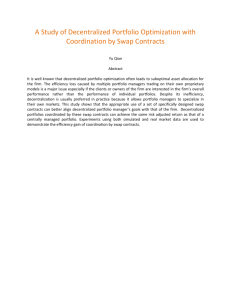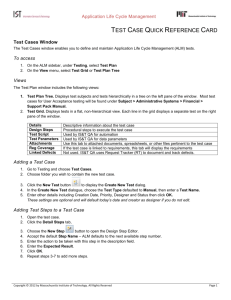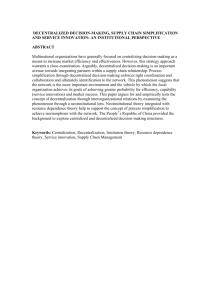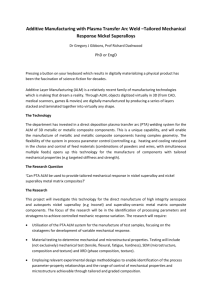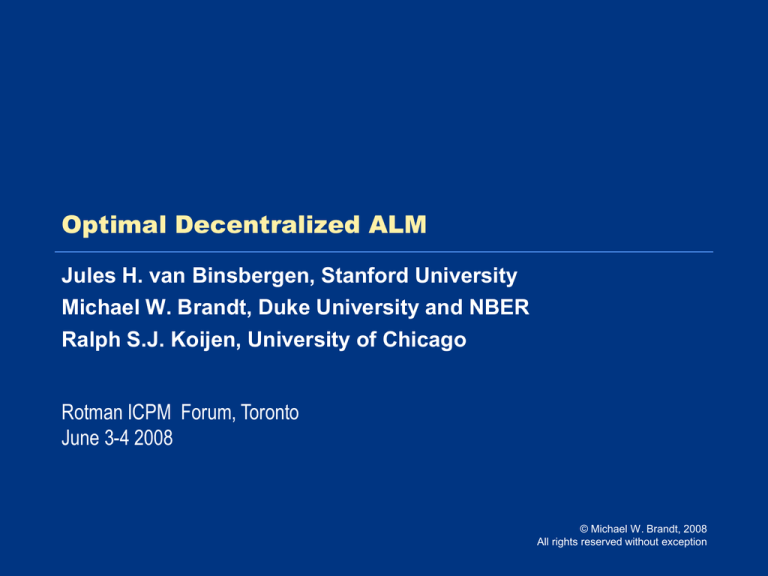
Optimal Decentralized ALM
Jules H. van Binsbergen, Stanford University
Michael W. Brandt, Duke University and NBER
Ralph S.J. Koijen, University of Chicago
Rotman ICPM Forum, Toronto
June 3-4 2008
© Michael W. Brandt, 2008
All rights reserved without exception
Motivation
Motivation
Decentralized investment management
• Institutions decentralize investment decisions along asset classes
– Example
CIO
Fixed Income
Portfolio Manager
Equities
Portfolio Manager
– Why?
Division of labor
Specialization ) Generating value (i.e., lower transaction cost or
positive alpha) within an asset class requires specialized skill
© Michael W. Brandt 2008
3
Optimal Decentralized ALM
Motivation
Misalignment of objectives
1. Suboptimal diversification
– Joint optimization by CIO over all assets dominates best
combination of portfolios optimized by portfolio managers
within asset-classes
– Sharpe (1981) and Elton and Gruber (2004)
2. Different risk preferences
– Portfolio managers take more or less risk than CIO desires
– CIO does not generally know the managers’ risk preferences
– van Binsbergen, Brandt, and Koijen (2008)
3. Mismatch risk between assets and liabilities
– Portfolio managers do not consider liabilities in their optimization
– Main motivation for this project
© Michael W. Brandt 2008
4
Optimal Decentralized ALM
Motivation
Benchmarking
• Performance benchmarks are commonly used to evaluate and
compensate portfolio managers
– Emphasis is on measuring effort or skill
– Benchmarks are taken as exogenously given (e.g., cash or index)
• We examine to what extent optimally designed benchmarks can
alleviate the misalignment induced by decentralization
• To be realistic, we focus on
– Benchmarks that are tradable portfolios and can be matched by
the portfolio managers (i.e., no cross-benchmarking)
– Benchmarks that do not depend on unknown quantities
– Unconditional benchmarks
© Michael W. Brandt 2008
5
Optimal Decentralized ALM
Motivation
Objective of our study
• Quantify in an intuitive way the economic cost of decentralization
– How much active skill do delegated portfolio managers have to
have in order to justify decentralization?
• Show how to construct benchmarks that perfectly align objectives
and achieve the same outcome as if the investment process was
centralized and the CIO had the skills of the portfolio managers
– Full benefits of diversification
– Optimal mismatch risk
– Optimal alpha overlay
© Michael W. Brandt 2008
6
Optimal Decentralized ALM
Motivation
Objective of our study (cont)
• Show how to operationalize our approach
– Our optimally constructed benchmarks depend on the portfolio
managers’ risk tolerances and active skill levels
– Three possibilities
Take an ex-ante stance on both sets of parameters
Construct an empirical cross-sectional distribution and
incorporate the resulting “parameter uncertainty”
Limit the role of both sets of parameters through constraints
Integrated and fully operational approach for decentralized
liability driven investment (LDI) management
© Michael W. Brandt 2008
7
Optimal Decentralized ALM
Problem setup
Problem setup
Pension fund
• CIO
– Liabilities
Exogenous with Treasury-like dynamics
– Assets
Centralized portfolio management (7 assets)
– Fixed income indices (Aaa, Baa, and Treasuries)
– Equity indices (Growth, Intermediate, Value)
– Cash
Decentralized portfolio management (3 assets)
– Fixed income manager
– Indices + orthogonal alpha technology
– Equities manager
– Indices + orthogonal alpha technology
– Cash
– Preferences = power utility over AT/LT
© Michael W. Brandt 2008
9
Optimal Decentralized ALM
Problem setup
Portfolio managers
• Fixed income manager (4 assets)
– Indices (Aaa, Baa, Treasuries)
– Independent alpha technology
– No cash position
– Preferences = power utility over A1T/B1T
• Equities manager (4 assets)
– Indices (Growth, Intermediate, Value)
– Independent alpha technology
– No cash position
– Preferences = power utility over A2T/B2T
• Two types of benchmarks (cash or optimally chosen)
© Michael W. Brandt 2008
10
Optimal Decentralized ALM
Cost of decentralization
Cost of decentralization
Decomposition
Cost of Decentralization
=
Suboptimal Diversification
+
Asset/Liability Mismatch
Alpha
© Michael W. Brandt 2008
12
Optimal Decentralized ALM
Cost of decentralization
Suboptimal diversification
• Cash benchmarks
• No alpha technologies
• Portfolio managers have relative risk aversion of 10
© Michael W. Brandt 2008
13
Optimal Decentralized ALM
Cost of decentralization
Centralized ALM
• CIO’s optimal allocation to the 6 risky assets
max SR weights
liability hedging weights
• Note
– No liability hedging with ° = 1 (log utility)
– Full liability immunization as ° ! 1
© Michael W. Brandt 2008
14
Optimal Decentralized ALM
Cost of decentralization
Centralized ALM (cont)
© Michael W. Brandt 2008
15
Optimal Decentralized ALM
Cost of decentralization
Decentralized ALM with cash benchmarks
• Both portfolio managers maximize their (absolute) SR
with
which includes their alpha technologies (technically ¤ ¤C)
• CIO invests optimally in the 2 managed portfolios and cash
© Michael W. Brandt 2008
16
Optimal Decentralized ALM
Cost of decentralization
Decentralized ALM with cash benchmarks (cont)
© Michael W. Brandt 2008
17
Optimal Decentralized ALM
Cost of decentralization
Cost of decentralization
• How much alpha do the portfolio managers have to add for the
CIO to be indifferent between centralized and decentralized ALM?
IR
© Michael W. Brandt 2008
18
Optimal Decentralized ALM
Optimal benchmarks for delegated ALM
Optimal benchmarks for decentralized ALM
Optimal benchmarks
• Response of the portfolio managers to benchmark with weights ¯i
• Note
– Benchmarks are ineffective with ° = 1 (log utility)
– Tracking error volatility ! 0 as ° ! 1
© Michael W. Brandt 2008
20
Optimal Decentralized ALM
Optimal benchmarks for decentralized ALM
Optimal benchmarks (cont)
• Understanding how portfolio managers respond to benchmarks,
the CIO’s optimal benchmark choice is
where xiC is the CIO’s optimal allocation to the portfolio manager’s
assets including the manager’s alpha technology
• These benchmarks induce the first-best solution
– Full benefits of diversification
– Optimal mismatch risk
– Optimal alpha overlay
Optimal benchmarks achieve the same outcome as if the
investment process was centralized and the CIO had the
skills of the portfolio managers
© Michael W. Brandt 2008
21
Optimal Decentralized ALM
Optimal benchmarks for decentralized ALM
Optimal benchmarks (cont)
© Michael W. Brandt 2008
22
Optimal Decentralized ALM
Optimal benchmarks for decentralized ALM
Optimal benchmarks (cont)
© Michael W. Brandt 2008
23
Optimal Decentralized ALM
Practical implementation
Practical implementation
Unknown quantities
• The optimal benchmarks depend on two unknown quantities
– Portfolio managers’ risk tolerance
– Portfolio managers’ active skill (IC)
• Unknown quantities can be dealt with the same way as they
usually are in portfolio choice problems
– “Plug-in” = pick values and proceed as if they known
– Bayesian = construct a subjective cross-sectional distribution of
risk tolerance and active skill levels (be careful, they are likely
highly correlated) and then integrate out the unknown quantities
© Michael W. Brandt 2008
25
Optimal Decentralized ALM
Practical implementation
Empirical solution
• Looking at past returns on active managers through the lens of a
structural model of delegated portfolio management (like ours),
we can learn a lot about managers’ risk preferences and skill
) Koijen (2008)
• Intuition
– Structural models predict how much beta exposure and active risk
managers take on as a function of their risk aversion and skill
– Beta exposure and active risk can be measured fairly accurately
(especially when compared to historical alpha estimates)
– These estimates can then be inverted to risk aversion and skill
© Michael W. Brandt 2008
26
Optimal Decentralized ALM
Practical implementation
Empirical solution (cont)
• E.g., cross-sectional distribution of relative risk aversion of U.S.
mutual fund managers
© Michael W. Brandt 2008
27
Optimal Decentralized ALM
Extensions and conclusions
Extension and conclusions
Extensions
• Long-only constraints
• Risk constraints at the portfolio manager level
• Alternative CIO preferences (van Binsbergen and Brandt, 2007)
• Other suggestions?
© Michael W. Brandt 2008
29
Optimal Decentralized ALM
Extension and conclusions
Conclusions
• Three contributions
– Quantify in an intuitive way the economic costs of decentralization
– Show how to construct benchmarks that perfectly align objectives
and achieve the same outcome as if the investment process was
centralized and the CIO had the skills of the portfolio managers
– Show how to operationalize our approach
• Integrated and fully operational approach for decentralized ALM
© Michael W. Brandt 2008
30
Optimal Decentralized ALM


